Abstract
With a booming expansion of urbanization, urban water consumption (WC) attracts increasing concerns in developing countries worldwide, particularly for megacities. In this study, an urban WC model for Shenzhen, a rapidly developing flagship megacity in South China from a small agrarian fishery village since 1979, was built up to simulate the WC changes (1994–2009) with aim to formulate local water resources management strategies. Basically, the model was constructed using a variety of methods including a back-propagation artificial neuron network (BP-ANN), a quadratic polynomial model, a regression and auto-regressive moving average combination model, and a Grey Verhulst model. Simulation of the WC was conducted using a multiple regression forecasting model and a BP-ANN model. The results from these two models showed that the BP-ANN model is outperformed. Subsequently, a series of social–economic and demographic scenarios were formulated to project WC (2011–2020) with uncertainty analysis. The results suggest that the total WC will increase slower and slower over the decade. It might approach a saturated threshold soon after 2020. Scenarios of WC incorporating uncertainty analysis aiming to provide reliable prediction results constitute the highlight of this study. This study will be beneficial to formulate appropriate sustainable development strategies of water resources for similar megacities in South China.





Similar content being viewed by others
References
Bougadis J, Adamowski K, Diduch R (2005) Short-term municipal water demand forecasting. HYDROLOGICAL PROCESSES. Hydrol Process 19:137–148. doi:10.1002/hyp.5763. Published online in Wiley InterScience (http://onlinelibrary.wiley.com/doi/10.1002/hyp.5763/pdf)
Box G, Jenkins G (1970) Time series analysis: forecasting and control. Holden-Day, San Francisco
Deng JL (2002) The basis of Grey theory. Press of Huazhong University of Science and Technology, Wuhan
Dube E, van der Zaag P (2003) Analysing water use patterns for demand management: the case of the city of Masvingo, Zimbabwe. Phys Chem Earth 28:805–815
Firat M, Turan ME, Yurdusev MA (2010) Comparative analysis of neural network techniques for predicting water consumption time series. J Hydrol 384(2010):46–51. doi:10.1016/j.jhydrol.2010.01.005
Jain A, Varshney AK, Joshi UC (2001) Shrot-term water demand forecast modeling at IIT Kanpur using artificial neural networks. Water Resour Manag 15:299–321
Jia SF (2001) Condition analysis of industrial water zero growth—the experiences of developed countries. Prog Geogr 20(1):21–58 (in Chinese)
Jia SF, Zhang SF (2003) Response of industrial water use to water price rising in Beijing. J Hydraul Eng 4:10–113 (in Chinese)
Jorgensen B, Graymore M, O’Toole K (2009) Household water use behavior: an integrated model. J Environ Manag 91(1):227–236
Kayacan E, Ulutas B, Kaynak O (2010) Grey system theory-based models in time series prediction. Expert Syst Appl 37:1784–1789
Liu J, Savenije HHG, Xu JX (2003) Forecast of water demand in Weinan City in China using WDF-ANN model. Phys Chem Earth 28(2003):219–224. doi:10.1016/S1474-7065(03)00026-3
Maidment DR, Miaou SP, Crawford MM (1985) Transfer function models of daily urban water use. Water Resour Res 21(4):425–432
Municipal Water Affairs Bureau of Shenzhen (MWABS) (2007) The annual work summary of MWABS. http://www.szwrb.gov.cn/cn/zwgk_show.asp?id=18797
Municipal Water Affairs Bureau of Shenzhen (MWABS) (2009) The annual work summary of MWABS. http://www.szwrb.gov.cn/cn/zwgk_show.asp?id=18799
Municipal Water Affairs Bureau of Shenzhen (MWABS) (2011) Basic water regime information for Shenzhen. http://www.szwrb.gov.cn/cn/zwgk_show.asp?id=16069 (in Chinese)
Statistics Bureau of Shenzhen (SBS) (2011) Statistical Yearbook of Shenzhen (2010). http://www.sztj.com/main/xxgk/tjsj/tjnj/8140.shtml (in Chinese)
Verhulst PF (1838) Notice sur la loi que la population pursuit dans son accroissement. Corresp Math Phys 10:113–121
Viswanathan MN (1985) Effect of restrictions on water consumption levels in Newcastle. Hunter District Water Board, Bandon Grove
Wang Z, Hu Y (2007) Applied time series analysis. Science Press, Beijing
Wang X, Burgess A, Yang J (2012) A scenario-based water conservation planning support system (SB-WCPSS). Stoch Environ Res Risk Assess. doi:10.1007/s00477-012-0628-3
Wei S, Gnauck A, Lei A (2009) Simulation analysis of domestic water demand and its future uncertainty in water scarce areas. Front Earth Sci China 3(3):349–360
Wong JS, Zhang Q, Chen YD (2010) Statistical modeling of daily urban water consumption in Hong Kong: trend, changing patterns, and forecast. Water Resour Res 46:W03506. doi:10.1029/2009WR008147
Yurdusev MA, Firat M, Turan ME (2010) Generalized regression neural networks for municipal water consumption prediction. J Stat Comput Simul 80(4):477–478. doi:10.1080/00949650903520118
Zang X (2005) Industry economics. Press of Economic Science, Beijing, pp 319–320 (in Chinese with English abstract)
Zhang P (2010) Empirical study on the water demand during the evolution of industrial structure: evidence from Shenzhen. Technol Econ 29(7):65–71 (in Chinese with English abstract)
Zhang Z, Shao Y, Xu Z (2010) Prediction of urban water demand on the basis of Engel’s coefficient and Hoffmann index: case studies in Beijing and Jinan, China. Water Sci Technol 62(2):410–418
Acknowledgments
The work was jointly supported by grants the National Basic Research Program of China (2010CB951101) and grants from the National Natural Science Foundation of China (40901016, 40830639, 40830640, 41071020).
Author information
Authors and Affiliations
Corresponding author
Rights and permissions
About this article
Cite this article
Shi, P., Yang, T., Chen, X. et al. Urban water consumption in a rapidly developing flagship megacity of South China: prospective scenarios and implications. Stoch Environ Res Risk Assess 27, 1359–1370 (2013). https://doi.org/10.1007/s00477-012-0672-z
Published:
Issue Date:
DOI: https://doi.org/10.1007/s00477-012-0672-z




